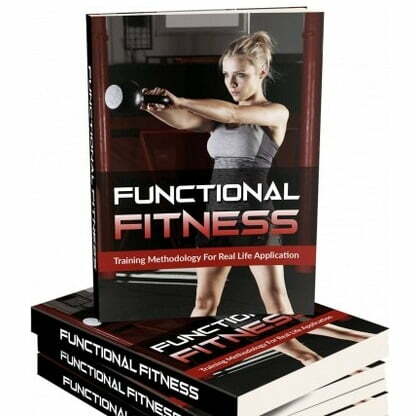Imagine waking up every morning feeling energized, ready to conquer your day! This was the thought that drove Anna, a busy professional, to explore functional fitness. It’s not just about how you look; it's about how you feel and function in your daily life. If you've ever struggled with motivation to hit the gym or find yourself lost in fitness trends, this guide on functional fitness will provide the essential tips and insights you need to flourish.
What is Functional Fitness?
Functional fitness is a term that has gained popularity in recent years. But what does it really mean? In simple terms, functional fitness refers to exercises that mimic everyday movements. This type of fitness focuses on enhancing one’s ability to perform daily tasks with ease. Think about it: when you bend down to pick something up or lift a grocery bag, you're using functional movements. The goal here is to improve your overall functionality and strength in real-life scenarios.
The Importance of Functional Movements
Why are functional movements so crucial? They help in building strength, balance, and flexibility. These elements are essential for daily activities. For instance, when you squat to tie your shoes, you’re engaging muscles that support your body’s structure. This is where functional fitness shines. It trains your body to handle daily challenges more efficiently.
Enhances daily living: Functional fitness makes chores easier.
Prevents injuries: By strengthening muscles used in daily tasks, it reduces the risk of injuries.
Improves balance: Better balance means fewer falls, especially as one ages.
How Functional Fitness Differs from Traditional Workouts
Functional fitness stands apart from traditional workouts in several ways. Traditional workouts often focus on isolated muscle groups. For example, doing bicep curls primarily targets the arm muscles. In contrast, functional fitness incorporates compound movements. These movements engage multiple muscle groups simultaneously. For instance, a deadlift works the legs, back, and core all at once. This holistic approach is more aligned with how we move in real life.
Moreover, functional fitness is adaptable. It is accessible to all fitness levels. Whether someone is a beginner or an experienced athlete, they can benefit from functional training. This is a significant difference from many traditional workouts, which may require specific equipment or advanced techniques.
Common Misconceptions about Functional Fitness
Despite its benefits, there are misconceptions surrounding functional fitness. Some people think it’s only for athletes or those who are already fit. This is simply not true. Functional fitness is for everyone. It can be tailored to fit individual needs and abilities. Another misconception is that functional fitness lacks intensity. However, this type of training can be just as rigorous as traditional workouts, depending on how it's structured.
As a fitness expert once said,
'Functional fitness helps improve our ability to perform daily activities with ease.'
This statement perfectly encapsulates the essence of functional fitness.
In summary, functional fitness emphasizes exercises designed to make everyday activities easier. It’s about enhancing your quality of life through better movement, strength, and flexibility. So, next time you think about working out, consider how functional fitness can benefit you in your daily life.
The Benefits of Functional Fitness
Functional fitness is not just a trend; it's a lifestyle choice that can lead to significant improvements in one's health and well-being. This approach to fitness focuses on exercises that mimic everyday activities. It aims to enhance strength, balance, and flexibility. But what are the real benefits of functional fitness? Let's explore.
1. Improved Strength and Conditioning
One of the primary benefits of functional fitness is improved strength and conditioning. Unlike traditional workouts that isolate single muscle groups, functional exercises engage multiple muscles. This means that when a person performs a squat, for example, they are not just working their legs. They are also engaging their core and back muscles. This holistic approach leads to better overall strength.
2. Enhanced Flexibility and Balance
Flexibility and balance are crucial for daily activities. Imagine bending down to tie your shoes or reaching for something on a high shelf. Functional fitness incorporates movements that improve flexibility and balance. Stretching and dynamic movements help prevent injuries. As one fitness professional said,
'A functional fitness routine can significantly enhance quality of life.'
This statement rings true for many who have adopted this style of training.
3. Greater Overall Health and Prevention of Injuries
Functional fitness promotes greater overall health. It emphasizes movements that improve cardiovascular health and muscular endurance. By training the body to perform everyday tasks efficiently, individuals can reduce the risk of injury. For instance, a strong core can prevent back injuries when lifting heavy objects. Flexibility is also key. It allows the body to move freely, reducing the chances of strains or sprains.
4. Increased Energy for Daily Activities
Many individuals report higher energy levels after engaging in functional training routines. This boost in energy can be attributed to improved strength and conditioning. When the body is more efficient at performing tasks, daily activities feel less taxing. Whether it’s playing with children or completing household chores, functional fitness prepares the body for these challenges.
Notes on Functional Fitness
Functional exercises often involve multiple muscle groups working together.
Flexibility is crucial for injury prevention.
Incorporating functional fitness into a regular exercise routine can lead to remarkable changes. It’s not just about looking good; it’s about feeling good. The benefits extend beyond the gym. They influence daily life, making tasks easier and more enjoyable.
Overall, functional fitness is a powerful tool for enhancing health and well-being. It’s a practical approach that prepares individuals for the physical demands of everyday life. With improved strength, flexibility, and energy, the quality of life can significantly improve.
Crafting Your Functional Fitness Journey
First Steps to Implementing Functional Fitness
Starting any fitness journey can feel overwhelming. However, the first step in functional fitness is to focus on bodyweight exercises. These exercises are effective for beginners. Why? They require no equipment and can be done anywhere. Think of squats, push-ups, or lunges. They mimic daily activities, making them practical.
It's essential to set realistic goals. Aiming too high can lead to frustration. Instead, focus on small, achievable targets. For instance, aim to complete five push-ups in a row before progressing. This approach builds confidence and encourages consistency.
Choosing the Right Exercises for Your Goals
Next, consider your personal goals. Are you looking to improve strength, flexibility, or balance? Each goal requires different exercises. For strength, incorporate movements like squats and deadlifts. For flexibility, try stretching routines or yoga.
Functional fitness is about real-world applications. Therefore, select exercises that mimic daily tasks. For example, if lifting groceries is challenging, focus on exercises that strengthen your core and legs. This targeted approach ensures that your workouts are beneficial beyond the gym.
Creating a Schedule That Fits Your Lifestyle
Consistency is key in fitness. Create a workout schedule that fits your lifestyle. If mornings are hectic, consider evening workouts. Aim for at least three sessions per week. Each session can be as short as 15 minutes. The goal is to make exercise a regular part of your life.
Use a calendar or an app to track your workouts. This helps you stay accountable. Plus, seeing your progress can be motivating. Remember, 'Start small, think big—functional fitness is a journey, not a sprint.' - Motivational Coach.
Advice on Assessing Progress Over Time
Assessing your progress is crucial. It helps you understand what's working and what isn’t. Keep a journal of your workouts. Note the exercises, sets, and reps. This record allows for easy reflection and adjustment in your routine.
Additionally, consider taking photos or measurements. Sometimes, changes aren’t visible immediately, but they are happening. Celebrate small victories, like lifting heavier weights or completing an extra set. These milestones keep motivation high.
Incorporating functional exercises into daily routines requires minimal equipment. It can be done anywhere, making it accessible for everyone. Whether at home, in a park, or at the gym, functional fitness adapts to your environment.
Common Mistakes to Avoid in Functional Fitness
Functional fitness is a popular approach to exercise. It emphasizes movements that help individuals perform daily tasks more effectively. However, many beginners make mistakes that can hinder their progress. Here are some common pitfalls to watch out for.
1. Neglecting Mobility and Flexibility Training
One significant mistake is ignoring mobility and flexibility training. Many people think strength is all that matters. But flexibility is crucial for overall fitness. Without proper mobility, movements can become restricted. This limitation increases the risk of injury. It’s like trying to drive a car with a flat tire; it just won’t work efficiently.
Incorporate stretching routines.
Consider yoga or Pilates for flexibility.
Focus on dynamic warm-ups before workouts.
2. Overtraining Without Proper Recovery
Another common error is overtraining. Some individuals push their bodies too hard without allowing for recovery. This can lead to burnout or injuries. Recovery is as important as the workout itself. Think of your body like a smartphone. If you never charge it, it will eventually die.
Listen to your body; rest when needed.
Schedule recovery days into your routine.
Prioritize sleep and nutrition.
3. Focusing Too Much on Aesthetics Instead of Functionality
Many fitness enthusiasts focus heavily on aesthetics. They want to look good, which is understandable. However, functional fitness is about more than just appearance. It's about improving functional strength. When workouts are aesthetic-focused, they may neglect essential movements. This can lead to imbalances and weaknesses.
Ask yourself: Are you training for how you look or how you move? Strive for a balance that promotes both. Functional fitness should enhance daily activities, not just your physique.
4. Ignoring Fundamentals of Body Mechanics
Finally, ignoring body mechanics can be detrimental. Understanding how the body moves helps prevent injuries. It’s vital to learn proper techniques and form. Many people skip this step, leading to poor habits. This is like trying to build a house without a solid foundation. It may look good initially, but it won’t last.
Take time to learn proper form.
Consider working with a trainer for guidance.
Focus on mastering basic movements before progressing.
'Avoid the pitfalls while aiming for progress is essential to a successful fitness journey.' - Health Advisor
In conclusion, many beginners fall into the trap of following trends rather than foundational principles of functional fitness. By avoiding these common mistakes, individuals can create a more effective and enjoyable fitness journey. Remember, functional fitness is not just a trend; it’s a lifestyle choice that promotes health and well-being.
Understanding body mechanics can prevent injuries. Balance workouts with recovery and rest days. This approach will lead to sustainable progress and a healthier lifestyle.
Quick Workouts for a Busy Lifestyle
In today’s fast-paced world, finding time to exercise can be a challenge. However, short workouts can be both effective and manageable. With just 15 minutes, individuals can kickstart their fitness journey. These quick routines are designed for busy lifestyles, allowing people to fit exercise into their daily schedules.
1. 15-Minute Workout Routines to Get Started
Fifteen minutes may seem like a short time, but it can make a significant difference. Many people might ask, “Can I really achieve anything in just 15 minutes?” The answer is a resounding yes! Here are some suggestions:
High-Intensity Interval Training (HIIT): Alternate between short bursts of intense activity and rest.
Bodyweight exercises: Squats, push-ups, and lunges can be done in a short amount of time.
Yoga or stretching: Focus on flexibility and relaxation, which can be done quickly.
As a fitness trainer once said,
“Even a 15-minute workout can transform your health when done regularly.”
2. Morning Exercises to Kickstart Your Day
Morning workouts have their own unique benefits. They can boost energy levels and set a positive tone for the day. Think about it: How often do people feel more productive after a workout? Morning exercises can include:
Brisk walking or jogging: A quick run can wake up the body.
Short yoga sessions: These can improve flexibility and clear the mind.
Quick strength training: Use resistance bands or bodyweight exercises to build muscle.
Integrating these routines into the morning can lead to increased productivity throughout the day.
3. Combining Strength and Flexibility in Short Time Frames
Another essential aspect of quick workouts is the combination of strength and flexibility. By integrating both, individuals can achieve a well-rounded fitness routine. For instance, performing a set of strength exercises followed by stretching can maximize benefits. This approach not only builds muscle but also enhances mobility.
4. The Role of Consistency and Mindset in Short Workouts
Consistency is key. Short workouts can be effective only when done regularly. It’s essential to create a routine that fits into one’s lifestyle. Moreover, maintaining a positive mindset is crucial. Individuals should remind themselves of the benefits of working out, even if it’s just for a few minutes each day.
In conclusion, quick workouts are a viable option for those with busy schedules. Functional fitness can seamlessly fit into daily lives, making it easier to stay active. With just 15 minutes, people can start their journey toward better health. By committing to short, effective routines, they can enhance their well-being without sacrificing their time. Embrace the challenge and discover the benefits of quick workouts today!



